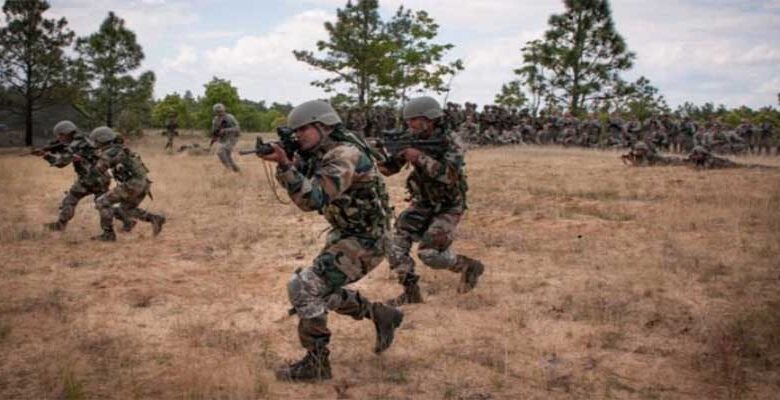The Indian Army is ramping up its artillery strength along the China border with a series of new procurements aimed at enhancing its firepower and surveillance capabilities. This strategic move includes the acquisition of an additional batch of 100 K9 Vajra self-propelled howitzers, swarm drones, loitering munitions, and advanced surveillance systems. The Director General of Artillery, Lieutenant General Adosh Kumar, emphasized that these procurements are essential to meet the challenges posed by national security concerns, especially along sensitive frontier regions.
India’s decision to augment its artillery forces comes at a time of heightened geopolitical tensions with China, especially along the Line of Actual Control (LAC). The expansion of the artillery arsenal is a crucial part of the country’s defense strategy to ensure it is well-prepared for any potential conflict or escalation along the disputed border. The K9 Vajra, which is a highly mobile self-propelled artillery gun, is expected to play a pivotal role in boosting the firepower of the Indian Army’s artillery regiments.
Lieutenant General Adosh Kumar stated that the focus of the Army’s artillery modernization plan is not only on conventional weapons but also on integrating futuristic technologies. “We are looking at a holistic upgrade, which includes high-precision, long-range artillery systems, and the incorporation of new-age technologies like drones and loitering munitions. This will greatly enhance the operational efficiency and firepower of our artillery,” he said, while speaking about the modernization efforts. The combination of advanced weaponry and state-of-the-art surveillance systems is expected to provide the Army with a substantial tactical edge in high-altitude, difficult terrains along the border.
The K9 Vajra howitzer, developed under a technology transfer agreement between India and South Korea, has already proven its mettle in desert and mountainous regions. These 155 mm, 52-caliber artillery guns can strike targets up to 50 kilometers away and offer flexibility in difficult terrain due to their mobility and speed. Given the topographical challenges along the LAC, the addition of 100 more units is likely to bolster the Army’s ability to respond swiftly and effectively to any threat. The Vajra’s capacity to operate in varied climatic conditions also aligns with India’s growing emphasis on enhancing defense capabilities in mountainous regions, including Ladakh and Arunachal Pradesh.
The deployment of swarm drones and loitering munitions, part of the Army’s broader modernization plan, marks a shift towards network-centric warfare. Swarm drones, which operate in coordinated groups, offer the capability to overwhelm enemy defenses by launching multiple attacks simultaneously. These drones are expected to improve reconnaissance and provide real-time data, which is critical in modern-day warfare, especially in areas where traditional surveillance methods may face limitations.
Loitering munitions, often referred to as “suicide drones,” are another key component of the Army’s evolving strategy. These systems can hover over target areas for extended periods before engaging, allowing for precision strikes on enemy positions or high-value targets. By incorporating these advanced technologies, the Indian Army aims to create an integrated force capable of conducting both defensive and offensive operations along the border with greater precision and efficiency.
Lieutenant General Kumar also highlighted the role of enhanced surveillance systems, which are being deployed to ensure better monitoring of the border. The introduction of high-altitude, long-endurance drones and advanced radar systems will provide real-time situational awareness and reduce the chances of surprise incursions. “Surveillance is key in high-altitude areas, where ground patrols may not always be effective. The use of drones and other monitoring equipment will allow us to maintain a constant vigil and ensure early detection of any potential threat,” Kumar added.
The Indian Army’s focus on upgrading its artillery comes at a time when China is also modernizing its forces along the LAC. Beijing has reportedly deployed advanced missile systems, artillery units, and unmanned aerial vehicles (UAVs) in areas bordering India, raising concerns in New Delhi about the growing militarization of the region. India’s acquisition of new artillery systems and surveillance tools is seen as a direct response to these developments, aimed at maintaining a balance of power and deterrence along the border.
The ongoing standoff between Indian and Chinese troops, particularly in eastern Ladakh, has underscored the need for stronger military preparedness. The deployment of additional artillery units and advanced technologies is seen as a critical part of India’s strategy to secure its territorial integrity in the face of external threats. Over the past few years, the Army has undertaken several measures to strengthen its position, including infrastructure development along the border, the construction of all-weather roads, and the enhancement of air defense capabilities.
Apart from bolstering its conventional artillery, the Indian Army is also focusing on precision-guided munitions (PGMs) that offer greater accuracy in targeting enemy positions. The adoption of PGMs is part of the broader effort to minimize collateral damage and improve strike efficiency in complex battlefield environments. The integration of PGMs with existing artillery systems like the K9 Vajra is expected to give the Army a significant advantage in both defensive and offensive operations.




 SEBI Board Set to Address Allegations at Crucial Meeting Today
SEBI Board Set to Address Allegations at Crucial Meeting Today 